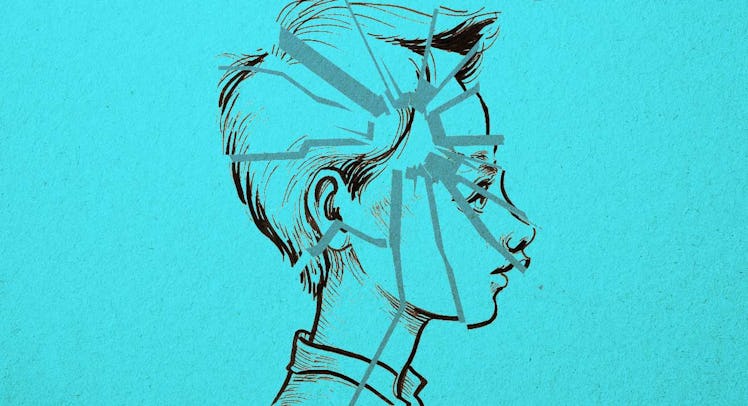Michael Ian Black’s Problematic ‘Broken Boy’ Theory of School Shootings
Do boys need more and better help? Yes. Does that explain murder? Absolutely not.

In a New York Times op-ed published this week, comedian Michael Ian Black attempted to contextualize the Parkland school shooting by describing a growing population of “broken boys,” young men trapped by understandings of masculinity and self-worth at odds with the current culture. These boys, Black lamented, slip through the cracks between outdated ideas of powerful masculinity and a current dialogue on gender that focuses more on girls and women. Black asserted that, left to “withdraw and rage,” these boys are more likely to commit grotesque acts of violence — to become the murderers that stalked the school halls in Parkland and Sandy Hook.
It’s always tempting to reach for a cultural explanation for horror — particularly when the cultural debate has taken a turn for the confrontative and when rationality wilts in the face of the facts. But this sort of reasoning assumes that individual behavior emerges from collective behavior, which is not precisely true and is imprecisely reductive. In his piece, Michael Ian Black, who is smart, well-intentioned, and, this op-ed aside, very funny, does not, for instance, interrogate trends in violence, in mental health, or in the wellbeing of children. And he sidesteps discussions related to race, the media, and the 22-caliber elephant in the room, guns.
Ultimately, Black’s argument is sound and worth rereading, but pegged to the wrong story.
Let’s be clear from the outset: More effort should be made to speak to boys about their emotions, needs, and place in the world. That much is not really debatable and not really being debated — parents on the left and right use very different language (name-checking “radical feminism” or “toxic masculinity”) but ultimately seem to voice similar concerns. The problem with Black’s piece, which has been highly circulated, is not with that premise. The problem is with the tenuous connection between the lack of discourse around boyhood and the dead children in Florida.
Black’s piece makes (and this is actually not a criticism) a fairly broad strokes argument about the lack of focus on learned masculinity since the advent of the modern feminist movement. He argues that this has left boys unmoored and unsure of their own masculinity, thus susceptible to feelings of shame and anger. This may be true, but there’s no real evidence to support the idea that we’ve passed a cultural tipping point.
A 2012 study Journal of Child Psychology and Psychiatry conducted a meta-analysis on 30 years of data related to childhood depression. They found that adolescents were no more depressed today than they were in the past. More diagnosed? Sure. More depressed? Nope. What’s more, rates of depression, though stable, were slightly higher for girls. The authors pulled no punches in their conclusion: “If more depressed children are being identified, or are receiving antidepressant medication, this is more likely to be the result of increased sensitivity to a long-standing problem than of an ‘epidemic’.”
If not depression, which is characterized by the withdrawing behavior Black describes, the issue must be with the reclamation of masculinity through violence. Except, well, that doesn’t seem to be true either.
Data from the U.S Department of Justice’s Office of Juvenile Justice and Delinquency Prevention tells a different story. Since its peak in the mid-1990s violent adolescent crime has plummeted by nearly 60 percent. Looking at a smaller snapshot, the OJJDP’s Violent Crime index showed that arrest rates declined 38 percent for white youth and 34 percent for black youth in the six years between 2006 and 2012 (which is the last year data was available).
But what about youth victimization, considering most of these incidents occur in schools? It’s the same story. Things are getting better. There has been a 61 percent decline in juvenile homicide victims between 1993 and 2015.
Does this suggest there’s not a problem with male violence? No. Juvenile boys are far more likely than females to commit homicide and their victims are far more likely to be other males. That said, it does suggest that school shootings may represent a very specific behavior that ought not to be attributed to boys as an umbrella group.
Perpetrators of mass shootings are predominantly white. How does this figure into the argument? If school shooting are a problem of confused adolescent masculinity, why are the demographics so consistent? Are adolescent black boys immune from withdrawal and rage? Surely not. So there’s something worth interrogating there even if it is hard to understand and even harder to parse. (It’s also worth noting that black boys were labeled “super-predators” during the last high-crime era, not pathologized as merely alienated.) And it’s important to remember that these kids are also all American. Globalism has made the experience of growing up middle class fairly homogenous, but school shootings are not an issue in Europe.
So why are white male teenagers killing American kids? Motivations are hard to discern — and that’s an argument for spending more time looking into it and listening — but at least half the answer comes down to opportunity. They can. They have access to powerful firearms. If you can’t get your hands on an AR-15, you can’t kill people with an AR-15.
Should young boys and men be empowered in a positive way and helped to grapple with the difficulty of lingering expectations? Yes, there is a virtue in that and Black makes some resonant points. But the issue here seems to be that one of the ways in which Americans empower themselves is by possessing and using weaponry. Shooters empower themselves and their murderous intent with guns. Empowerment can be a very dangerous thing.